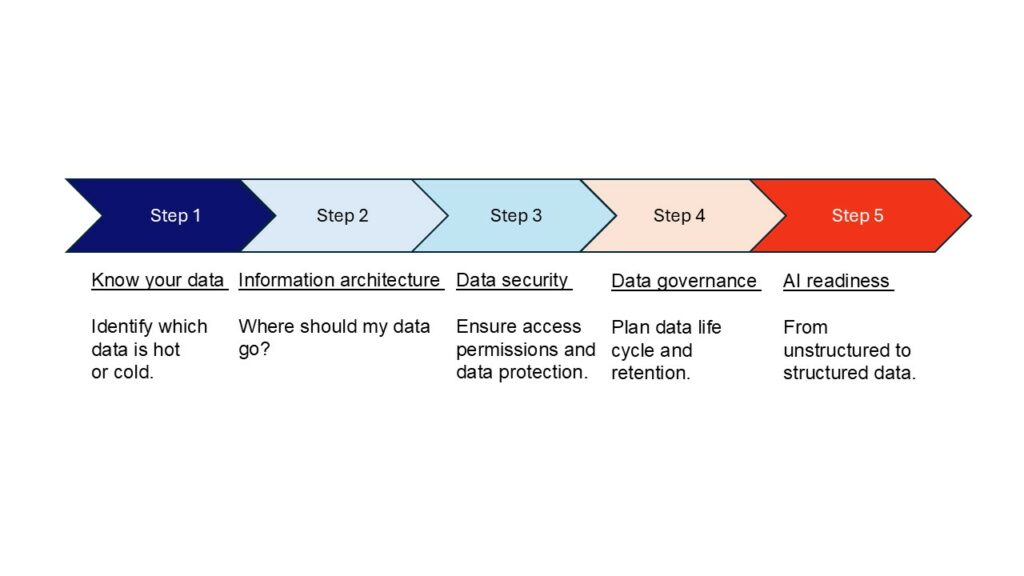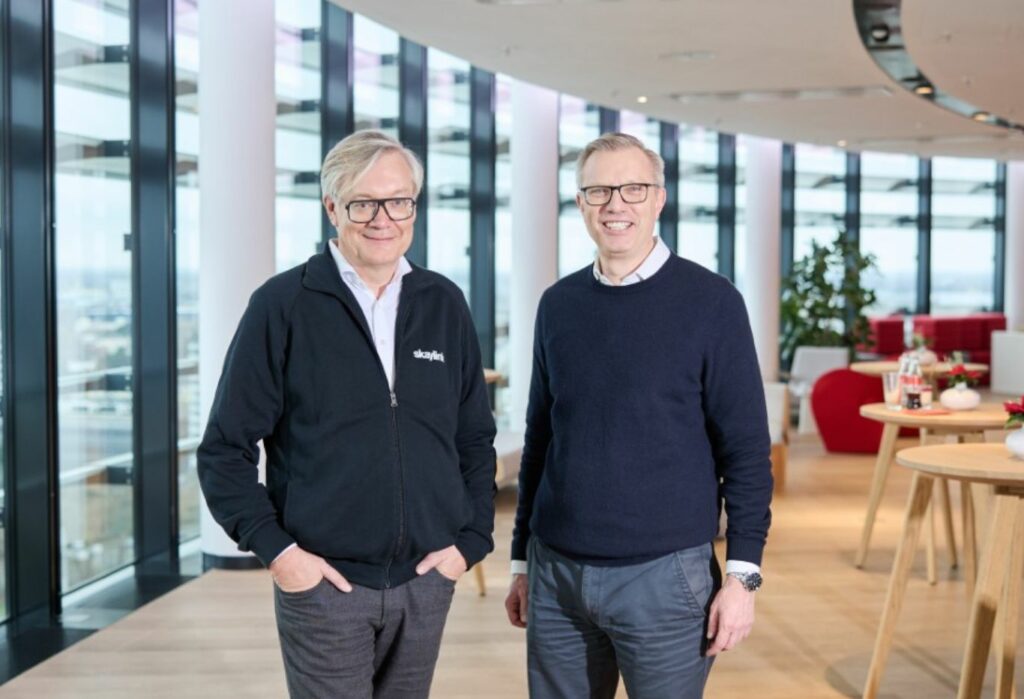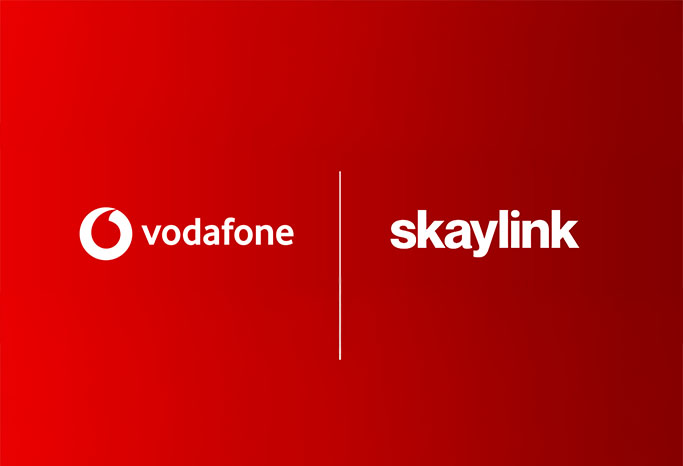Home / Uncategorized / Migrate the right way

Blog
Migrate the right way

Some time ago, a company faced significant challenges due to an outdated file storage system, which affected employee efficiency and satisfaction. The difficulty of locating and sharing documents made daily tasks unnecessarily complex. To address this issue, the company decided to transition to an M365 tenant, integrating SharePoint Online, OneDrive for Business, and Teams.
What started as a straightforward data migration from a file share quickly turned into a comprehensive overhaul, as the company uncovered the multifaceted possibilities of the new AI era. Initially focused solely on transferring data, the company soon realized there was much more to consider. This unexpected journey brought information architecture and data security to the forefront, reshaping the company’s approach and revealing new opportunities for efficiency and innovation.
Collaborating with a partner company and following a comprehensive assessment of the existing system, the company developed a new intranet that transformed the previously chaotic environment into a well-organized workspace. New governance regulations were established, and employees were trained to foster a culture of consistency and compliance.
To protect sensitive data, advanced security measures such as encryption and multi-factor authentication were implemented. Additionally, the integration of artificial intelligence facilitated the automated file organization and tagging, enabling employees to swiftly locate documents using natural language queries.
“Migrate the right way” successfully marked the conclusion of this transformation by combining a smooth migration with AI. The results have been remarkable: productivity has soared as employees spend less time retrieving documents. The new file structure has enhanced collaboration, while robust security measures have mitigated the risk of data breaches. Compliance with the new data management regulations has minimized legal and regulatory risks, and the improved efficiency and user-friendliness of the system have led to higher employee satisfaction.
The plan – how to get there?
When embarking on a new project, it’s crucial to consider future needs and adopt the right approach from the outset. This ensures long-term adaptability and sustainability. With this in mind, discussions around the plan revealed that migrating the file server involved far more than simply copying data from A to B. In particular, the lack of a site topology and the long-term goal of implementing AI complicated the process.
The following 5-step plan was agreed upon:

Key elements
In addition, the plan included these key elements:
- Long-term vision: Establish a clear long-term vision for the project that will guide all decisions and help align the team’s efforts towards common goals.
- Scalability: Design the project with scalability in mind by creating systems and processes that can grow and evolve as the project expands.
- Flexibility: Incorporate flexibility to adapt to changing circumstances by using modular designs and agile methodologies that allow for adjustments without significant disruption.
- Stakeholder engagement: Engage stakeholders early and often, as their input and feedback are invaluable in shaping the project’s direction and ensuring it meets their needs.
- Continuous improvement: Foster a culture of continuous improvement by regularly reviewing and refining processes to enhance efficiency and effectiveness.
With the project stages and work packages defined, the work started following the schematic plan above.
Step 1: Know your data
First, the data on the file servers was identified according to the organizational structure by mapping departments to SharePoint sites as migration targets. Project-related data was mapped to Teams sites, while personal data was mapped to OneDrive for Business sites.
Next, the data was analyzed to determine whether it was:
- Hot data that is actively used and/or required for daily business.
- Cold data that could be moved to an archive solution.
- Obsolete data that can be deleted.
- Highly secure data that must remain on-premises for specific reasons or due to regulatory requirements.
Step 2: Where should my data go?
The next stage focused on considerations of information architecture and site topology to
select the right structure, such as a modern intranet (hub site, home site, etc.), and to determine which site templates to use (Teams team site, communication site, standard SharePoint team site, etc.)
Step 3: Data security
Depending on the site structure and intranet design, a new permission matrix was planned to be implemented. Once the data is migrated, it inherits the target set of permissions to clean up any historically accumulated permission issues and prepare for AI readiness at the end.
The different data types at each level were also identified based on certain characteristics, similar to labels such as internal, confidential or strictly confidential data by leveraging Microsoft Purview Solutions.
Step 4: Data governance
In addition to the previous considerations regarding new permissions and access controls, it was also recognized that the data life cycle and retention must be planned accordingly.
Step 5: AI readiness
As part of the foundational work of setting the right permissions, controlling access to sensitive data and managing data governance, the path to successful AI implementation has been laid.
By considering all these aspects and adopting the right approach from the outset, you can lay the foundation for a successful and sustainable project, aligned with the principles of “Migrate the right way”.
Conclusion
What started as a straightforward data migration has turned into both a substantial transformation and journey, enabling the company to meet contemporary requirements for cloud and AI readiness.
The scalability of cloud solutions and AI resulting from this evolution has brought several benefits:
- Scalable and cost-effective cloud resources allow the company to pay only for what they use.
- This approach leads to both mid- and long–term cost optimization, while enabling the adoption of new technologies such as AI.
- Employee efficiency has significantly enhanced.
- Knowledge sharing and content discovery have greatly improved.
If you find yourself in a similar situation, don’t hesitate to reach out to Skaylink. We’re here to partner with you and guide you on your journey to “Migrate the right way”.
Skaylink is a leading service provider for cloud and digital transformation. We help medium-sized and large companies rapidly and securely transform to the cloud and efficiently build and operate modern cloud solutions. You get the complete portfolio for your digital journey from a single source thanks to more than 550 cloud experts for AWS, Azure and M365, as well as our own data centers.
Applying wide-ranging cloud expertise, proven frameworks, established best practices, innovative methodologies, and a suite of intuitive software-based tools, we deliver fast, secure, and compliant digital transformation for all, regardless of sector or jurisdiction.
Your journey starts now – take the first step today!
These articles might interest you

- Press

- Blog

- Press